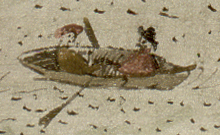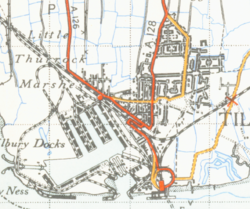Tilbury: Difference between revisions
m Reverted edits by Joericks123 to last version by Woohookitty (HG) |
Joericks123 (talk | contribs) No edit summary |
||
| Line 4: | Line 4: | ||
|unitary_england= [[Thurrock]] |
|unitary_england= [[Thurrock]] |
||
|lieutenancy_england= [[Essex]] |
|lieutenancy_england= [[Essex]] |
||
|region= |
|region= buthole |
||
|country= England |
|country= England |
||
|latitude= 51.4606 |
|latitude= 51.4606 |
||
Revision as of 12:59, 3 October 2008
| Tilbury | |
|---|---|
| Population | Expression error: "12,091 (2001 Census)" must be numeric |
| OS grid reference | TQ639761 |
| Unitary authority | |
| Ceremonial county | |
| Country | England |
| Sovereign state | United Kingdom |
| Post town | TILBURY |
| Postcode district | RM18 |
| Dialling code | 01375 |
| UK Parliament | |
Tilbury is a town in the borough of Thurrock, Essex, England. As a settlement it is of relatively recent existence, although it has important historical connections, being the location of a 16th century fort, and an ancient cross-river ferry. It is also the location of a modern deep water port.
Etymology
The name ‘’Tilbury Town’’ is derived (via the port) from the nearby settlements of East and West Tilbury. The name of these settlements is derived from the Saxon ’’burgh’’ - a fortified place - either belonging to Tila, or perhaps at a lowland place[1]. The 8th century spelling (Bede) was ’’Tilaburg’’, and the spelling in Domesday was Tilberia. [2]
History
Tilbury’s history is closely connected with its geographical location (see below). Its counterpart on the south bank of the River Thames, Gravesend, has long had an important part to play insofar as communications are concerned, and it was to that town that a cross-river ferry (see below) was connected, mainly due to the fact of the narrowness of the river at this point. In addition Gravesend and Northfleet (also on the south shore) both became vitally important to shipping: the former as the first port of call for foreign shipping bound for London; and the latter as a naval dockyard. The area has therefore had a long connection with shipping on the River Thames.
There is archaelogical evidence of Roman occupation. At the time, sea-levels had dropped, making the marshes habitable. There may well have been a Roman settlement on the site of what is now Tilbury Docks.[3]. In the 12th century the river, which had hitherto consisted of difficult channels with uncharted shoals, was changed by the process of embanking the river and enclosing areas of marsh. This improved the river's flow, and also resulted in improved land resources on the marsh[4]. It was nevertheless an unhealthy place in which to live - Daniel Defoe [5], who, in 1696, operated a tile and brick factory in the Tilbury marshes[6] and lived in a nearby house, wrote about "the Essex ague".
In 1588 Queen Elizabeth I came ashore here to review her main army at the nearby village of West Tilbury (see Speech to the Troops at Tilbury).
In 1852 an Act of Parliament had authorised the building of the London Tilbury and Southend Railway (LTSR), with a short spur to take advantage of the ferry over the Thames; a pier nearby was constructed for the steamboat traffic. The station was originally named Tilbury Fort and opened in 1854. The station was renamed Tilbury Riverside in 1936[7].
A few houses were built for the railway workers, but it was not until the construction of Tilbury Docks (see below) that there was any settlement worthy of a name. Whilst the docks were being built, the thousands of workers were provided either with temporary accommodation, or had to commute from surrounding villages and towns. The resultant overcrowding led to the building of more permanent accommodation once the docks were completed, including tenement blocks; but these were poorly constructed, and until the formation of Tilbury District Council (see below) the town was in a poor state; it remained so until 1918, when government funds were available to better the situation[8].
The Tilbury Ferry
The Tilbury - Gravesend Ferry has operated from very early times. A sketch-map of 1571[9], shows evidence of two jetties; the one on the north bank leading to a road crossing the marsh northwards. There are also houses marked on the marsh itself which became important for sheep grazing, and there is some evidence to suggest that the ferry was used for the transport cross-river of the animals and the wool[10]

Although the 17th-century drawing might suggest a boat too small for large consignments, the long-established Gravesend market would certainly encourage such traffic, and a contemporary account suggests that one of the boats used was a hoy, a forerunner of the Thames sailing barge[11].
Tilbury Fort
The curve and narrowness of the river here made it a suitable place to construct forts for the defence of London against foreign invaders. The first permanent fort at Tilbury[12] was a D-shaped blockhouse built in 1539 by Henry VIII and initially called the 'Thermitage Bulwark', because it was on the site of a hermitage dissolved in 1536. The Tilbury blockhouse was designed to cross-fire with a similar structure at New Tavern, Gravesend. During the Armada campaign the fort was reinforced with earthworks and a palisade and there was a boom of ships' masts, chains and cables stretched across the Thames to Gravesend anchored to lighters. The Fort was rebuilt under Charles I and is now owned by English Heritage.
Governance
Until 1903, the marshland area was part of the traditional parish and civil parish of Chadwell St Mary, which reached south to the river Thames. The parish of Tilbury Docks was established in 1903 and the Tilbury Urban District Council (UDC) in 1912; it was to merge with Thurrock UDC in 1936. This in turn became a borough in 1984 and in 1998 the Thurrock Unitary Authority.
There are two wards covering the town, both served by four councillors: Tilbury Riverside and Thurrock Park for the southern part; and Tilbury St Chads in the north[13].
The Member of Parliament for Thurrock is Andrew Mackinlay.
Geography
The town of Tilbury is located on the north bank of the River Thames, where the river’s meander has caused it to narrow to approximately 800 yards (732 m) in width. The area to the north is one-time marshlands; to the north of that there is higher ground on which the villages of Chadwell St Mary, West and East Tilbury are situated.
The town lies to the north of the London-Southend railway line and is bounded on the north by marshland.
The Port of Tilbury
The Port of Tilbury handles a variety of bulk cargo, timber, cars and container traffic and remains, along with Southampton and Felixstowe, one of Britain's three major container ports. It is the main UK port for importing paper including newsprint. The one-time passenger landing stage was reopened by the Port of Tilbury group as the London Cruise Terminal, though no longer served by the railway.

Demography
Economy
Until containerisation, the majority of the town’s inhabitants were employed in the Docks. The resultant loss of employment opportunities has never been made up, and Tilbury today has high unemployment; and poor prospects as far as education and employment are concerned[14]
Landmarks
The major landmarks are the docks, the cruise ship landing stage, and the Tilbury Power Station
Transport
Thurrock Council, (together with Kent County Council), subsidises the ferry between Tilbury and Gravesend which is currently operated by the Lower Thames & Medway Passenger Boat Company.
Tilbury Town railway station is on the c2c (London, Tilbury and Southend) rail route. Tilbury Riverside railway station was closed on 29 November 1992, although the railway still serves the nearby container depot[15]. A bus service now connects Tilbury Town railway station and the ferry.
Ensignbus services 66,73,80 and 83 serve Tilbury. National Cycle Route 13 from London to Norfolk passes through the town.
Religious sites
There are two churches in Tilbury: St Johns CofE and Our Lady Star of the Sea RC; there is also a Convent of Mercy. There is, in addition, a synagogue in Dock Road [16].
Education
The educational institutions in Tilbury include the southern site of the Gateway Community College[17]; and those for primary education, which are Lansdowne Primary School; St Mary’s RC Primary School and Tilbury Manor Primary Schools. The latter serve Infant and Nursery; and Junior children.
Culture
The Tilbury Band, dating from 1919, is among the leading brass bands in the UK [18].
Notable people
Among notable people having some connection with the town, there are two football players: John Evans (1929-2004), who played for Liverpool; and Tom Scannell (1925-1994]]. Noel Betowski (1952- ), artist, was born here; and Thomas Horrocks Openshaw (1856-1929) was a consultant surgeon at Tilbury Hospital.
Appearances in film and television
Tilbury and its environs have been used in some TV episodes. Tilbury Fort was used as a location for "Sharpe's Regiment", starring [[Sean Bean]; an episode of London's Burning (A fireman drama show) which was shot in the old fire station, in Civic Square in Tilbury; whilst a scene from an episode of James Nesbitt's Murphy's Law was filmed at Tilbury Docks' Cruise Terminal.[citation needed] The Port of Tilbury has been used on numerous occasions and Derek Ross
References
- ^ James Kemble, Essex Plac-Names (Historical Publications, 2007)
- ^ London Thames Gateway Forum
- ^ FCJ Spurrell, Early sites and embankments on the margins of the Thames estuary (in The Archaeological Journal, 1885)
- ^ The Book of Gravesham Sydney Harker, 1979 ISBN 0 86023 091 0
- ^ Defoe. D. (1724). A tour thro' the Whole Island of Great Britain.
- ^ The business failed in 1703
- ^ Disused stations: site record (Subterranean Britannica)
- ^ Thurrock: a Visionary Brief in the Thames Gateway
- ^ Drawn by a one-time Portreve (Mayor) of Gravesend, William Bourne, and included in The Book of Gravesham Sydney Harker, 1979 ISBN 0 86023 091 0]
- ^ Tilbury Ferry: historical notes
- ^ Journey described by Celia Fiennes
- ^ Tilbury Fort
- ^ Thurrock Council
- ^ Thurrock: a Visionary Brief in the Thames Gateway
- ^ Tilbury Riverside station (Subterranea Britannica
- ^ Tilbury churches etc
- ^ Gateway Community College
- ^ The Tilbury Band
